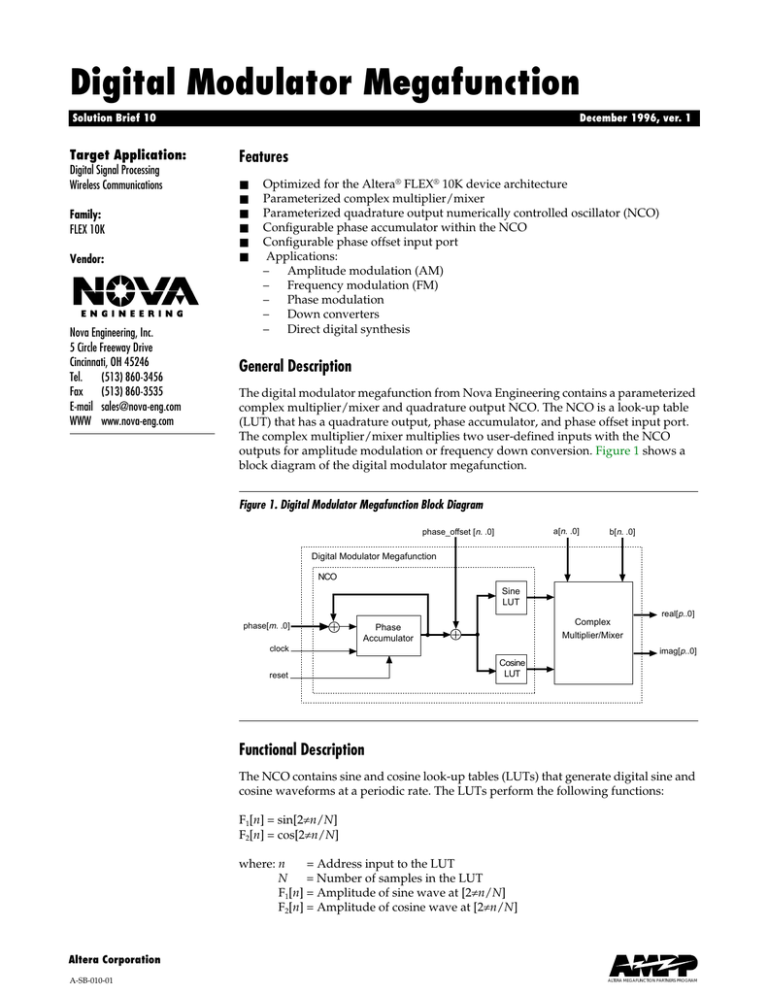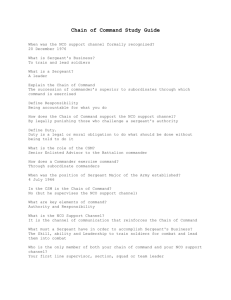
Digital Modulator Megafunction
Solution Brief 10
Target Application:
Digital Signal Processing
Wireless Communications
Family:
FLEX 10K
Vendor:
Nova Engineering, Inc.
5 Circle Freeway Drive
Cincinnati, OH 45246
Tel.
(513) 860-3456
Fax (513) 860-3535
E-mail sales@nova-eng.com
WWW www.nova-eng.com
December 1996, ver. 1
Features
■
■
■
■
■
■
Optimized for the Altera® FLEX® 10K device architecture
Parameterized complex multiplier/mixer
Parameterized quadrature output numerically controlled oscillator (NCO)
Configurable phase accumulator within the NCO
Configurable phase offset input port
Applications:
– Amplitude modulation (AM)
– Frequency modulation (FM)
– Phase modulation
– Down converters
– Direct digital synthesis
General Description
The digital modulator megafunction from Nova Engineering contains a parameterized
complex multiplier/mixer and quadrature output NCO. The NCO is a look-up table
(LUT) that has a quadrature output, phase accumulator, and phase offset input port.
The complex multiplier/mixer multiplies two user-defined inputs with the NCO
outputs for amplitude modulation or frequency down conversion. Figure 1 shows a
block diagram of the digital modulator megafunction.
Figure 1. Digital Modulator Megafunction Block Diagram
a[n. .0]
phase_offset [n. .0]
b[n. .0]
Digital Modulator Megafunction
8
8
NCO
Sine
LUT
8
10
phase[m. .0]
Phase
Accumulator
clock
reset
real[p..0]
Complex
Multiplier/Mixer
10
imag[p..0]
Cosine
LUT
8
Functional Description
The NCO contains sine and cosine look-up tables (LUTs) that generate digital sine and
cosine waveforms at a periodic rate. The LUTs perform the following functions:
F1[n] = sin[2πn/N]
F2[n] = cos[2πn/N]
= Address input to the LUT
where: n
N
= Number of samples in the LUT
F1[n] = Amplitude of sine wave at [2πn/N]
F2[n] = Amplitude of cosine wave at [2πn/N]
Altera Corporation
A-SB-010-01
ALTERA MEGAFUNCTION
MEGAFUNCTION PARTNERS
ALTERA
PARTNERS PROGRAM
PROGRAM
SB 10: Digital Modulator Megafunction
Incrementing n from 0 to N causes the LUT to output one complete cycle of amplitude
values for the sine and cosine functions. The value 2πn/N represents a fractional phase
angle between 0 (n = 0) and 2π (n = N). The time (t) required to increment n from 0 to N,
is the period of the sine and cosine waveforms produced by the NCO. Moreover, an
m-bit phase input generates the addresses for the quadrature NCO. The LUT address
increments once each system clock cycle by an amount equal to the phase input. The
LUT address, or phase angle, is accumulated and stored in the phase accumulator
register. The register’s output is used to address the sine and cosine LUTs.
The frequency (ƒ) of the system clock (fCLOCK) is fixed. Therefore, the frequency of the
sine and cosine waves produced by the NCO is:
ƒ = 1/T = (fCLOCK × phase) / 2m
where: phase = Input phase angle
The phase_offset input modulates the NCO phase angle. The value from the
phase_offset input is summed with the phase accumulator output. Both values, as
well as the sum, are represented in two’s complement format.
The complex multiplier/mixer can multiply two complex numbers represented in
two’s complement format. It uses a parallel-pipelined architecture that provides
maximum speed. The complex multiplier/mixer performs the following function:
real + jimag = (a + jb) × (c + jd)
where: j
= ( –1 )
real = (a × c) – (b × d)
imag = (a × d) + (b × c)
The total latency of the modulator from the phase input to the real output is 6 clock
cycles. The output of the complex multiplier/mixer is registered to improve speed
without increasing the number of logic cells used.
Ports
Table 1 describes the megafunction’s ports.
Table 1. Digital Modulator Megafunction Ports
Name
phase [m. . 0]
2
Type
Input
Size
Description
12 to 32 bits Specifies the NCO frequency in two’s
complement format.
phase_offset [n. . 0] Input
1 to 10 bits
Specifies the NCO phase offset from 0° in
two’s complement format.
a [n . 0], b [n. . 0]
Input
1 to 8 bits
Complex data that are multiplied with the
NCO outputs. Two’s complement format.
clock
reset
real [p. . 0]
Input
–
System clock.
Input
–
Asynchronous system reset, active high.
Output
4 to 8 bits
Real part of complex result. Two’s
complement format.
imag [p. . 0]
Output
4 to 8 bits
Imaginary part of complex result. Two’s
complement format.
Altera Corporation
SB 10: Digital Modulator Megafunction
Parameters
Nova Engineering can customize the phase accumulator width, phase offset port width,
NCO’s LUT output width, and complex multiplier/mixer width to meet user
specifications. The user can also request that functional blocks be removed or optionally
bypassed. These custom-built parameters eliminate unnecessary logic and optimize the
megafunction for specific applications.
Performance
Table 2 illustrates the device utilization and maximum clock frequency for a typical
digital modulator megafunction in an EPF10K20-3 device. Custom configurations will
differ in logic cell usage and performance.
Table 2. Typical Device Utilization for the Digital Modulator Megafunction in an EPF10K20-3 Device
Implementation
Clock (fMAX)
Logic Cells
EABs
35 MHz
662
2
phase = 24 bits;
phase_offset = 10 bits;
a, b = 8 bits;
Outputs = 8 bits
Applications
The functional building blocks—the NCO, phase offset input port, and a complex
multipler/mixer—allow the megafunction to implement a variety of modulators such
as the amplitude, frequency, and phase modulators.
Amplitude Modulation
The designer begins by setting the NCO to a desired frequency. To program the NCO,
the designer should select the appropriate phase word and system clock and set the
phase_offset value to zero. The NCO will generate the desired sinusoidal waveform.
The complex multiplier/mixer combines the NCO output with the a and b inputs. The
output signal at the real port is:
real[p..0] = (a × cos (n)) – (b × sin (n))
Input b should be set to zero. The resulting AM sinusoid appears in two’s complement
form at the real output. The user can apply binary data to the most significant bit
(MSB) of port a to create amplitude shift keying (ASK).
Quadrature amplitude modulation (QAM) is accomplished in a similar manner, except
ports a and b are used to input the complex vector to be transmitted. The QAM signal
appears at the real output in two’s complement format.
Frequency Modulation
FM requires the user to modulate the phase input to the NCO. To program the NCO to
the desired center frequency, select the appropriate phase word and system clock and
set the phase_offset value to zero.
Altera Corporation
3
SB 10: Digital Modulator Megafunction
The data source can modulate the NCO frequency in several ways. After the data
signals are digitized, they are added to the phase input. Each time the data changes, the
phase input changes, which consequently changes the NCO frequency. The FM
deviation, or maximum frequency change, can be controlled by scaling the data input.
The maximum data value should correspond to a numerical value that increases the
NCO frequency to the desired upper frequency limit. The minimum data value should
correspond to the two’s complement of the upper frequency limit. FM deviation and
symmetry are accomplished by scaling the digital data source.
In addition, binary data can change the NCO frequency by controlling the multiplexers.
Binary frequency shift keying (FSK) requires two phase words and a 2-to-1
multiplexer. A binary 1 selects one phase word and a binary 0 selects the other phase
word to apply to the NCO. The serial binary data stream toggles the multiplexer to
select one of the two phase words. Each selected phase word controls a desired NCO
frequency. The user can also create an M-ary FSK by combining several bits to select
one of M phase words. For example, a 8-ary FSK transmitter specifies one of 8 different
frequencies to transmit on an 8-to-1 multiplexer using 3 select bits. The receiver then
uses this frequency in a priority encoder to determine the 3 select bits.
Phase Modulation
Phase modulation is accomplished by imparting the data information onto the phase
accumulator output. The phase_offset input port is provided for this purpose. To
program the NCO to the desired frequency, select the appropriate phase word and
system clock.
Binary phase shift keying (BPSK) is accomplished in the same way as FSK. That is, a
2-to-1 multiplexer selects one phase_offset word to apply to the phase_offset input
port. In BPSK, the binary data transmitted can be applied to the MSB of the
phase_offset input port. The user should set the a input to its maximum value and
the b input to its minimum value (zero). The resulting BPSK waveform appears at the
real output.
Quadrature phase shift keying (QPSK) is a composite of two BPSK waveforms in
quadrature phase alignment. QPSK requires that the a and b inputs be set to the
maximum value. It also requires a 4-to-1 multiplexer to select one phase_offset
word to apply to the phase_offset input port. The resulting QPSK waveform appears
at the real output port.
®
2610 Orchard Parkway
San Jose, CA 95134-2020
(408) 894-7000
http://www.altera.com
4
Copyright 1996 Altera Corporation. Altera, AMPP, FLEX, and FLEX 10K are trademarks and/or service marks of Altera Corporation in the
United States and other countries. Other brands or products are trademarks of their respective holders. The specifications contained herein
are subject to change without notice. Altera assumes no responsibility or liability arising out of the application or use of any information,
product, or service described herein except as expressly agreed to in writing by Altera Corporation. Altera customers are advised to obtain the
latest version of device specifications before relying on any published information and before placing orders for products or services. All rights
reserved.
Altera Corporation


